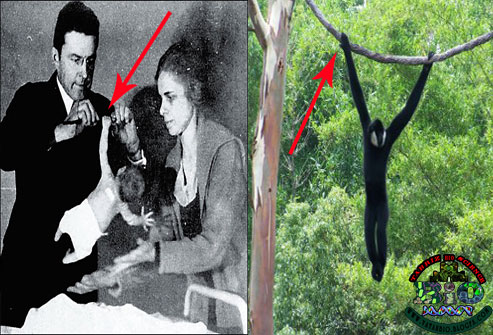پاسخ : رفتارها و رفلکس های وستیجیال (vestigial behaviors and reflexes)
جالبه...ولی من خونده بودم این یه الگوی عمل ثابته fap .....منبعتون چیه؟ شایدم یه نوع انعکاس باشه...خب اگه وستیجاله چرا الان ما نداریمش؟ فقط نوزادا دارن...سلیقه ای بنظر میرسه
Humans also bear some vestigial behaviors and reflexes. For example, the formation of goose bumps in humans under stress is a vestigial reflex;[47] a possible function in human evolutionary ancestors was to raise the body's hair, making the ancestor appear larger and scaring off predators. Raising the hair is also used to trap an extra layer of air, keeping an animal warm. Due to the diminished amount of hair in humans, the reflex formation of goose bumps when cold is also vestigial.
The palmar grasp reflex is supported to be a vestigial behavior in human infants. When placing a finger or object to the palm of an infant, it will securely grasp it. This grasp is found to be rather strong.[48] Some infants—37% according to a 1932 study—are able to support their own weight from a rod,[49] although there is no way they can cling to their mother. The grasp is also evident in the feet too. When a baby is sitting down, its prehensile feet assume a curled-in posture, much like what is observed in an adult chimp.[50][51] An ancestral primate would have had sufficient body hair to which an infant could cling unlike modern humans, thus allowing its mother to escape from danger, such as climbing up a tree in the presence of a predator without having to occupy her hands holding her baby.
It has been proposed that the hiccup is an evolutionary remnant of earlier amphibian respiration.[52] Amphibians such as tadpoles gulp air and water across their gills via a rather simple motor reflex akin to mammalian hiccuping. The motor pathways that enable hiccuping form early during fetal development, before the motor pathways that enable normal lung ventilation form. Thus, according to recapitulation theory the hiccup is evolutionarily antecedent to modern lung respiration. Additionally, they point out that hiccups and amphibian gulping are inhibited by elevated CO2 and may be stopped by GABAB receptor agonists, illustrating a possible shared physiology and evolutionary heritage. These proposals may explain why premature infants spend 2.5% of their time hiccuping[citation needed], possibly gulping like amphibians, as their lungs are not yet fully formed. Fetal intrauterine hiccups are of two types. The physiological type occurs prior to twenty-eight weeks after conception and tend to last five to ten minutes. These hiccups are part of fetal development and are associated with the myelination of the phrenic nerve, which primarily controls the thoracic diaphragm. The phylogeny hypothesis explains how the hiccup reflex might have evolved, and if there is not an explanation it may explain hiccups as an evolutionary remnant, held-over from our amphibious ancestors. This hypothesis has been questioned because of the existence of the afferent loop of the reflex, the fact that it does not explain the reason for glottic closure, and because the very short contraction of the hiccup is unlikely to have a significant strengthening effect on the slow-twitch muscles of respiration.
منبع :
Human vestigiality - Wikipedia, the free encyclopedia
---- دو نوشته به هم متصل شده است ----
جالبه...ولی من خونده بودم این یه الگوی عمل ثابته fap .....منبعتون چیه؟ شایدم یه نوع انعکاس باشه...خب اگه وستیجاله چرا الان ما نداریمش؟ فقط نوزادا دارن...سلیقه ای بنظر میرسه
متوجه منظورتون از سيليقه اي به نظر رسيدن را نمي شوم ؟
١- همه ي انسان ها الزاما اندام وستيجيال خاصي را ندارند (مثل ماهيچه ي پشت سر !)
٢- ايده ي من درمورد علتش : ما هنوز هم اين رفتار وستيجيال را داريم ولي كنترلش مي كنيم با أعصاب مركزي و محيطي . چون نوزاد شش ماهه هنوز هماهنگي كامل بين أعصاب و عضلات را ندارد اين رفتار خودش را بروز داده است .



